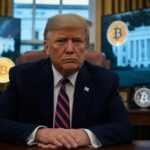Now Reading: The Impact of De-Dollarization on Gold: Should You Be Investing?
-
01
The Impact of De-Dollarization on Gold: Should You Be Investing?
The Impact of De-Dollarization on Gold: Should You Be Investing?
:max_bytes(150000):strip_icc()/burning-50-dollar-bill-103741994-5c5de7b046e0fb00014421a0.jpg?ssl=1)
:max_bytes(150000):strip_icc():format(jpeg)/burning-50-dollar-bill-103741994-5c5de7b046e0fb00014421a0.jpg)
Analysts and investors have been talking for years about de-dollarization the gradual shift by governments, companies, and investors away from using the U.S. dollar as the world’s default trading and reserve currency. In 2025, de-dollarization appears to be gaining speed.
New reports highlight how Southeast Asian and BRICS economies are formalizing local-currency trade-settlement schemes and encouraging companies to hedge less in dollars, responding to both currency volatility and geopolitical risks.
At the same time, central banks bought upwards of 244 metric tons of gold globally in the first quarter of 2025—well above the five-year quarterly average—even as private investors poured money back into gold-backed ETFs after two sluggish years.
As the dollar’s share of global reserves slips below 47% and gold’s share climbs toward 20%, dollar dominance may soon become a thing of the past, with gold replacing it once again as the world’s preferred reserve currency.
Key Takeaways
- De-dollarization appears to be accelerating in Asia and the broader Global South, eroding some of the dollar’s reserve-status luster.
- Central banks and retail investors are responding by accumulating gold, pushing prices to multi-year highs.
- Gold is a useful portfolio diversifier, but it is not an all-in bet; investors must weigh currency, liquidity, and opportunity costs.
De-Dollarization: From Rhetoric to Regional Policy
What changed recently is policy coordination. ASEAN’s 2026-30 Strategic Plan explicitly prioritizes local-currency settlement for trade and cross-border investment, a move analysts at Bank of America say could shrink dollar invoicing in the bloc by 15% within five years.
Political risk is another accelerant: President Trump’s protectionist policies are spooking some observers about the dollar’s stability, and emerging-market policymakers cite the 2022 seizure of Russian currency reserves as proof that dollar assets carry geopolitical haircuts.
Recent academic work on reserve-currency hierarchies predicts that once the perceived cost of holding dollars rises above a certain threshold, diversification becomes self-reinforcing, because the network benefits that anchored dollar primacy begin to dissipate.
Gold’s Renaissance
Gold has outperformed both the MSCI World Index and the Bloomberg Aggregate Bond Index so far in 2025, buoyed by relentless demand and a weaker Dollar Index. Meanwhile, the traditional negative correlation between gold and the the dollar over past decades still holds.
But today’s buying isn’t just about hedging dollar depreciation but also about rebuilding trust in a tangible store of value. Central bank buying is geographically diverse, and according to the World Gold Council, official sector demand now accounts for almost one-quarter of total annual gold inflows, the highest share since the late 1960s.
Gold ETF inflows have also surged, with global funds attracting about $30 billion in the first half of 2025 alone (amounting to ~322 accumulated tons)—the strongest start to a year for bullion funds since 2020, and after nearly $15 billion of net outflows in 2024.
In parallel, retail demand for physical gold, especially in places like India and China, has surged as households look for dollar-alternative savings options, a trend that could push spot prices well past $3,400 if replicated elsewhere.
How Investors Can React
Gold has long been viewed as a portfolio diversifier and inflation hedge, so investors may look to add or increase their allocation to the precious metal. Historical back-tests show that a 5%-10% allocation can lower overall portfolio drawdowns during market crises, while not materially reducing returns—even improving them in some cases. Investors can purchase physical bullion or coins, which offers zero counterparty risk but incurs storage and insurance costs. Low-expense ETFs (e.g., GLD, IAU) that track spot prices are often most convenient and liquid.
But de-dollarization is playing out on the currency front as well. Research cited by the Financial Times shows currency swings now account for roughly one-third of total portfolio variance for non-U.S. investors, with European pensions alone holding about $770 billion of unhedged dollar assets. U.S.-based investors expecting further dollar slippage might stay unhedged in foreign-equity ETFs, or look to inverse-dollar ETFs like UDN.
The Bottom Line
De-dollarization is not necessarily a doomsday scenario, but it is measurably reshaping global reserve management and investor psychology. The clearest winner so far is gold, whose dual identity as a commodity and a quasi-currency makes it a natural hedge against a fragmenting monetary order.













:max_bytes(150000):strip_icc()/GettyImages-22224708481-dd18828532454c61aae285d280f4c1ee.jpg?w=1024&resize=1024,1024&ssl=1)

:max_bytes(150000):strip_icc()/TSLAChart-b1e3b8a7c03a4dd3bd97b30271e1b558.gif?w=1024&resize=1024,1024&ssl=1)

![Just released: the 3 best growth-focused stocks to consider buying in July [PREMIUM PICKS] Just released: the 3 best growth-focused stocks to consider buying in July [PREMIUM PICKS]](https://i1.wp.com/www.fool.co.uk/wp-content/uploads/2022/10/Three.jpg?ssl=1)









-2.png?w=150&resize=150,150&ssl=1)
:max_bytes(150000):strip_icc()/GettyImages-22224708481-dd18828532454c61aae285d280f4c1ee.jpg?w=150&resize=150,150&ssl=1)


